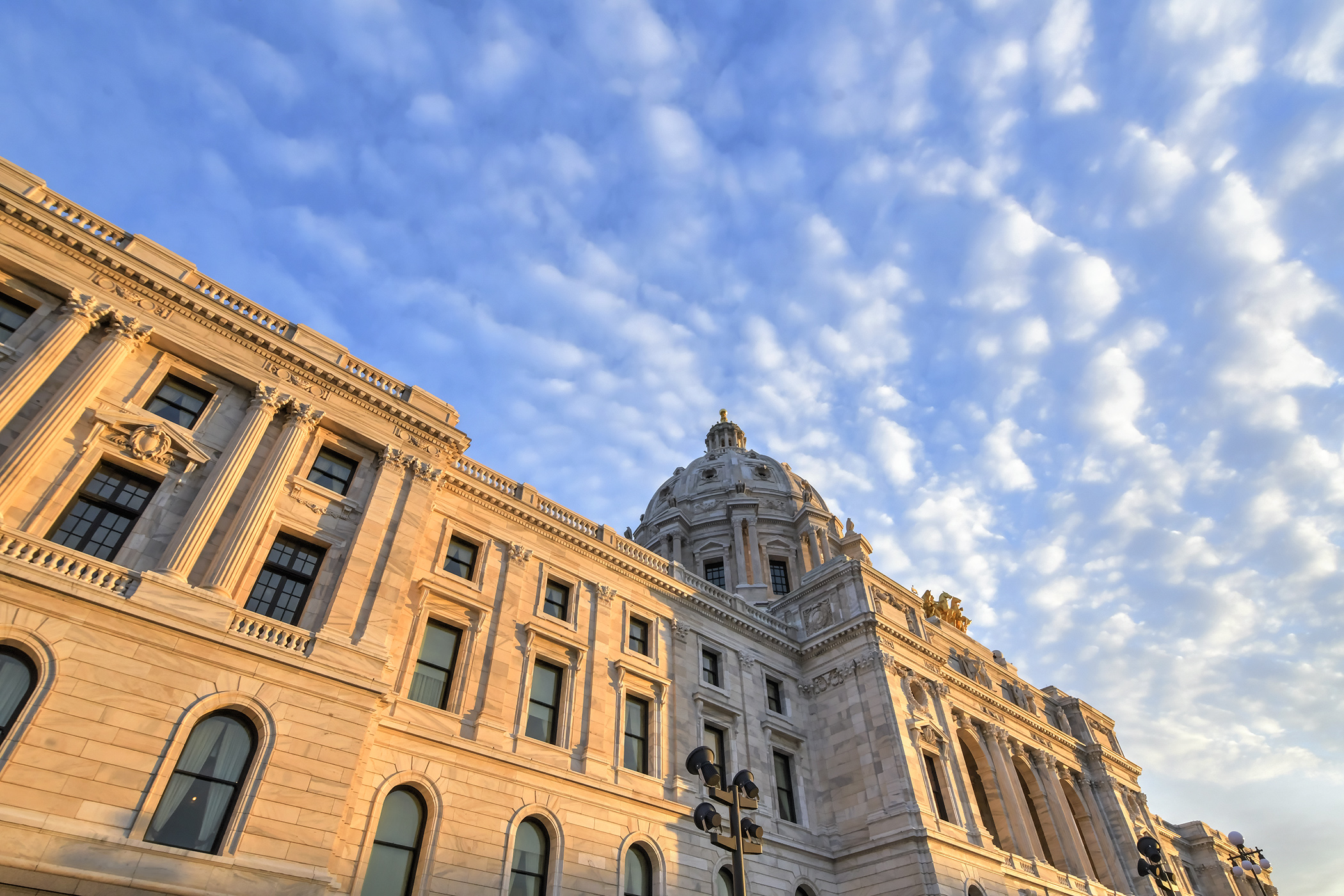Minnesota Youth Council presses on with legislative initiatives

The Minnesota Youth Council offers a unique opportunity for the state’s young people to connect with lawmakers, allowing them to share concerns and advocate for change.
Since the COVID-19 outbreak, many of those initiatives and concerns have become doubly important, according to Ava Kalenze, a junior at St. Anthony Village High School in the Twin Cities.
“I think we're kind of using the crisis as a way to uplift and further back our existing concerns,” she said. Kalenze has represented District Four on the council for three years and has served as chair for the past two years.
Much like the House of Representatives, the council has pressed on with legislative issues during this time of social distancing, but also like the House, some of its processes have changed.
Background and mission
In 2013, the Minnesota Youth Council was formally recognized by lawmakers and enacted into law. The group serves as the “voice of youth,” and advises the governor's office, Legislature and state departments on issues impacting students.
As the only legislatively mandated youth council of its kind in the country, it uses a youth-adult partnership model, and includes 36 young people who represent the state’s eight congressional districts.
“It’s just one of the most bright, and involved, and engaged groups of young people that I've ever met,” Kalenze said. “They all work really hard for issues that are not only important to them, but important to the youth in their community.”
Activities
At its core, the group strives to ensure equal access to learning opportunities and create better educational experiences, according to its website. It aims to do this through policy change and working with elected officials, from state lawmakers and local school boards, to local government officials.
 The council was formally recognized by lawmakers and enacted into law in 2013. (Image Courtesy the Minnesota Alliance With Youth)
The council was formally recognized by lawmakers and enacted into law in 2013. (Image Courtesy the Minnesota Alliance With Youth)“Not only does it use the skills that the young people on the council already have to lift up voices, but we also get so many new experiences that can kind of diversify our platform of skill,” Kalenze said.
In addition to actively engaging lawmakers, it partners with the Department of Education through a Student Advisory Committee. The group also holds its own meetings, and annually participates in Youth Day at the Capitol. The event serves to teach young people how to advocate, and it provides opportunities for them to meet with their elected officials.
Legislative priorities
Currently, the group’s most pressing legislative concerns include increasing mental health support for students, enhancing school safety, addressing racial equity in schools and requiring comprehensive sexual health education.
During the 2019-20 biennium, Kalenze said the group has worked closely with several representatives, including Rep. Kelly Moller (DFL-Shoreview), who is sponsoring HF4257 and HF3219, geared toward providing students with better mental health support.
“These needs were already there,” Moller said. “They were already really strong needs before the pandemic and now, in light of what’s going on, I think we’re only going to see an increase in growing mental health needs.”
Legislative impacts of COVID-19
As with nearly every other organization, the Minnesota Youth Council has been impacted by the coronavirus.
The group is legislatively mandated to have at least four bills heard in committee per legislative session. It must also participate in at least two hearings. Fortunately, these mandates were met before the coronavirus upended the Legislature’s regular process.
 “I think we're kind of using the [COVID-19] crisis as a way to uplift and further back our existing concerns,” said Ava Kalenze, an at-large member of the Minnesota Youth Council. (Image courtesy the Minnesota Youth Council)
“I think we're kind of using the [COVID-19] crisis as a way to uplift and further back our existing concerns,” said Ava Kalenze, an at-large member of the Minnesota Youth Council. (Image courtesy the Minnesota Youth Council)Since then, members have continued to engage by connecting with lawmakers through email and phone. They also continue to communicate their priorities through their website.
In response to the COVID-19 pandemic, they’ve posted a statement addressing topics like social distancing, mental and physical health, and distance learning. They plan to follow-up with one-page papers that dive into specific topics such as technology equity, blood donations and discrimination against Asian Americans, Kalenze said.
The issue of student mental health is possibly more pressing now than ever, she added, noting that access to school-linked mental health services has been reduced, and there is added stress brought on by the pandemic.
With less than a month left until the 2020 regular legislative session must constitutionally end by May 18, Kalenze recognizes it will be difficult to have the council’s priorities addressed, much less met. However, she’s still hopeful that additional support for students’ mental health will remain part of the discussion.
“I'd hope that at least the mental health bills would get seen and appreciated for what they are,” she said.
During a mid-March news conference, House Speaker Melissa Hortman (DFL-Brooklyn Park) said lawmakers will focus on three areas during the remainder of this session: bonding, COVID-19-related bills, and bills that have strong bipartisan support.
HF4257 falls into the latter category, and Moller said she’s actively working to see that it crosses the finish line. The bill would require teachers to have mental health and suicide prevention training before they’re relicensed. Currently, only some teachers undergo that training.
The bill includes a rulemaking component with a one-time appropriation of $14,000. Noting that the pandemic has led to budget constraints, Moller said that component could be removed.
“I don’t think the pandemic is certainly going to help things get better and these needs are just going to continue to grow and we’ve got to do something to try to address them,” Moller said.
She encourages Minnesota Youth Council members to continue to connect with their representatives and senators to convey their ongoing support for the proposal.
Sen. Carla Nelson (R-Rochester) sponsors the companion, SF3759, which awaits action by the Senate E-12 Finance and Policy Committee.
Personal impacts of COVID-19
Group members have stayed connected and have swapped stories about how the coronavirus is impacting their education and personal lives.
“I can only speak to my perspective, but we have had group discussions about how everybody's feeling, and everybody's experiencing very different things, but also very, very similar things,” Kalenze said.
The transition to distance learning has posed a challenge both technologically and socially. Some students do not have access to the equipment they need, while others, particularly in Greater Minnesota, don’t have access to broadband internet or reliable Wi-Fi. Distance learning has also impacted the social aspect of school, leading to some feeling isolated and lonely.
“Even though you complain about going to school every day, you still go because you can see your friends and you can do fun things,” Kalenze said. “But it's like all the fun has been taken out and it's just learning, and it's difficult.”
Related Articles
Search Session Daily
Advanced Search OptionsPriority Dailies
Ways and Means Committee OKs proposed $512 million supplemental budget on party-line vote
By Mike Cook Meeting more needs or fiscal irresponsibility is one way to sum up the differences among the two parties on a supplemental spending package a year after a $72 billion state budg...
Meeting more needs or fiscal irresponsibility is one way to sum up the differences among the two parties on a supplemental spending package a year after a $72 billion state budg...
Minnesota’s projected budget surplus balloons to $3.7 billion, but fiscal pressure still looms
By Rob Hubbard Just as Minnesota has experienced a warmer winter than usual, so has the state’s budget outlook warmed over the past few months.
On Thursday, Minnesota Management and Budget...
Just as Minnesota has experienced a warmer winter than usual, so has the state’s budget outlook warmed over the past few months.
On Thursday, Minnesota Management and Budget...